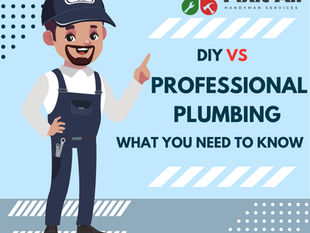
Common Plumbing Problems and Solutions: A Homeowner's Guide
1
4
0
Plumbing problems are an inevitable part of homeownership. Whether it's a dripping faucet or a clogged drain, these issues can be frustrating and, if left unchecked, can lead to more significant problems. Understanding common plumbing issues and their solutions can save you time, money, and stress. Here’s a guide to help you tackle some of the most frequent plumbing problems.
1. Dripping Faucets
Problem:A dripping faucet is one of the most common plumbing issues. While it might seem like a minor annoyance, a single dripping faucet can waste hundreds of gallons of water each year, leading to higher water bills.
Solution:In most cases, a dripping faucet is caused by a worn-out washer or O-ring inside the faucet. Replacing these small parts is a straightforward task that can be completed with basic tools. Turn off the water supply, disassemble the faucet, replace the damaged washer or O-ring, and reassemble the faucet. If the problem persists, you might need to replace the entire faucet cartridge or consult a plumber.
2. Clogged Drains
Problem:Clogged drains can occur in sinks, showers, or tubs and are often caused by a buildup of hair, soap scum, grease, and other debris. A slow drain can lead to standing water, unpleasant odors, and even potential water damage.
Solution:For minor clogs, a plunger or a drain snake can usually clear the blockage. Chemical drain cleaners are another option, but they should be used sparingly as they can damage pipes over time. For more stubborn clogs, try a mixture of baking soda and vinegar, followed by hot water. If the clog is deep or persistent, it may be time to call a plumber.
3. Running Toilets
Problem:A toilet that runs continuously after being flushed can waste a significant amount of water and drive up your utility bills. The most common cause is a faulty flapper valve that doesn’t seal properly.
Solution:First, remove the tank lid and inspect the flapper valve. If it’s worn or damaged, replace it with a new one. If the flapper is in good condition, check the chain connected to the flapper and make sure it's not too short or tangled. Adjusting the float arm or replacing the fill valve might also solve the problem. These parts are inexpensive and can be found at any hardware store.
4. Low Water Pressure
Problem:Low water pressure can make everyday tasks like showering and washing dishes frustratingly slow. This issue can be caused by various factors, including mineral buildup in pipes, a faulty pressure regulator, or leaks.
Solution:If the low pressure is isolated to a single faucet or showerhead, the cause may be a clogged aerator. Remove the aerator, soak it in vinegar to dissolve mineral deposits, and clean it thoroughly before reattaching it. If multiple fixtures are affected, check the pressure regulator or look for leaks in your plumbing system. If you can’t identify the source, it’s best to call a professional plumber to diagnose and fix the issue.
5. Leaking Pipes
Problem:Leaking pipes are a serious plumbing issue that can cause water damage, mold growth, and structural problems if not addressed promptly. Leaks can occur at joints, where pipes connect, or in the middle of pipes due to corrosion or damage.
Solution:If you notice a leak, turn off the water supply to the affected area immediately. For small leaks, you can use a pipe repair clamp or plumber’s tape as a temporary fix. However, it’s crucial to have the pipe repaired or replaced by a professional to prevent further damage. Regularly inspecting your pipes for signs of wear and corrosion can help prevent leaks from developing.
6. Water Heater Issues
Problem:Problems with your water heater can result in no hot water, inconsistent water temperature, or strange noises coming from the unit. These issues are often caused by sediment buildup, a faulty thermostat, or a malfunctioning heating element.
Solution:For inconsistent water temperature or no hot water, check the thermostat settings and adjust them if necessary. If you hear rumbling or popping noises, it may be due to sediment buildup in the tank. Flushing the tank can help remove the sediment and restore proper function. If the problem persists, it may require professional repair or replacement.
Conclusion
Plumbing problems are common, but many can be resolved with a bit of DIY knowledge and the right tools. Regular maintenance and prompt repairs can help prevent small issues from turning into costly repairs. However, if you encounter a plumbing problem that seems beyond your capabilities, don’t hesitate to call a licensed plumber. Their expertise can save you time, money, and the headache of dealing with more severe plumbing issues down the line.
#Plumbing #HomeMaintenance #DIYPlumbing #FixItYourself #PlumbingTips #HomeImprovement #LeakyFaucet #CloggedDrain #WaterPressure #RunningToilet #fixitallglobal






